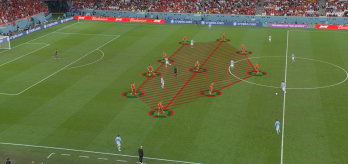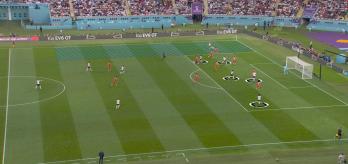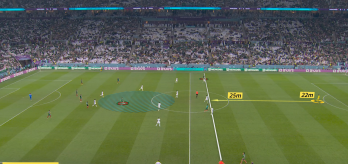It was also the first time the tournament was hosted during December, therefore changing many of the dynamics around team preparation and recovery leading into, and during, the competition.
As the world emerged from the Covid-19 pandemic, new regulations permitting the naming of 26-man squads and the use of five substitutions during matches, were maintained for this competition, adding another interesting dynamic.
The geography: one city, one team base, no travel once arrived
One of the most unique dynamics of this competition was its one-city dimension. Once teams landed in Doha, they could set up base for the entire duration of their World Cup journey with minimal travel demands. Due to the close proximity of hotels to stadiums and training facilities, players could be back in their rooms just two hours after their games finished, therefore greatly aiding recovery between training sessions and matches. It also meant that teams had a little more time to prepare for games tactically, with less travel commitments.
Winter: Mid-season, faster start to the tournament, best group stages ever
Because this tournament was played in winter months, players were coming into it mid-season with full match sharpness. There was a shorter lead-in time, so teams had a fast start once they assembled in camp. The group stages of the FIFA World Cup 2022 proved to be enthralling with every game in the last round having something at stake, with most teams still vying for spots in the round of 16, as the final group matches kicked off.
26-man squads: New group dynamics (15 non-starters)
In the aftermath of the Covid-19 pandemic and due to the timing of the competition, 26-man squads were permitted for the first time at a FIFA World Cup, meaning each team could name three additional players. The extra three players gave additional cover for injuries but also meant that players carrying knocks coming into the tournament could be included in the panels and engage in rehab with a view to being available later in the competition. Some head coaches chose to use the additional places for younger players and to give them the experience of tournament football.
The extra players also meant that coaches could play 11v11 games in preparation for their next games, even if some players were in recovery or carrying knocks. On the other hand, this new dynamic meant the majority (15) of the players were not starting matches meaning more players were potentially disappointed. It also added an additional challenge to managing training sessions. If all players were fit and available to train, there was a surplus of players for 11v11 training games.
Five substitutions: Change the game
The opportunity to use five substitutions in a game led to coaches being able to change half of their outfield players. This meant that fresh players could be introduced to maintain high energy levels and sustained physical output in relation to tactical strategies. It also facilitated complete changes in tactical approaches during the game meaning the timing and impact of substitutions could have a real bearing on the outcome of the matches.
It is noted in this tournament that substitutions were made earlier in games than in previous World Cups, with more changes registered between the 45–70-minute mark, particularly in the knockout stages.
FIFA’s Chief of Global Football Development, Arsène Wenger, explains how the five-substitution rule has really affected how a coach can change the game.
“When I was a young coach, if you dominated possession in the game for the first 70 minutes, you could make the difference in the last 20 minutes when the other team started to tire, make mistakes or have lapses in concentration. It’s not the case anymore.”
“The five substitutions gives coaches an opportunity to adapt tactically earlier in the game and to sort out fatigue problems.”
A standout game in relation to the impact of substitutions was the quarter-final clash between Netherlands and Argentina. By the 78th minute, Louis van Gaal had made the full complement of personnel changes, most notably the introduction of centre-forward, Wout Weghorst, which saw a complete shift in the tactical approach to a much more direct style. Weghorst scored two late goals to bring the scoreline back to 2-2 and forced the game into extra-time in one of the tournament’s most thrilling matches.
Similarly, in the final, Didier Deschamps made substitutions that saw France, at one stage with four strikers on the pitch (Mbappe, Thuram, Coman and Kolo Muani) as they clawed back a two-goal deficit and forced extra-time.
According to Cha Du-Ri, “It’s a double-edged sword because on the one hand, as a coach you have more options on the bench but then you also have three more non-starting players and in the World Cup, everyone wants to play. This means you have 15 players who are not starting, and this could affect squad morale.”
“As a coach it’s important to build a strong, positive team atmosphere, especially when the group is together for a long time. You must manage additional players who are potentially not happy about being on the bench and they require empathy and communication.”
Building a team around a star player
In the modern game, huge emphasis is placed on the ‘team’ game and every player being a ‘team’ player. When a team has players of the calibre of big personalities like Lionel Messi, Cristiano Ronaldo, Kylian Mbappe, Luka Modric, a coach can make the decision to reduce their team work in order to free them up for more game-changing opportunities. When these players make the difference, the rest of the team will accept working harder to compensate for them.
Special players bring an important dynamic to a team environment and also to big games for supporters. One of the most exciting attractions of the 2022 World Cup final was the opportunity to see so many world-class players. The World Cup final between Argentina and France was a gift for spectators across the globe, as Messi and Mbappe went into battle for goal-scoring supremacy.
According to Arsène Wenger, “Dominant personalities are part of the attraction of our game and sometimes, as coaches, we have to find compromises for them. If you are going to relieve them of some defensive duties, then you must balance your team with players around them who can absorb the extra work.”
“This was one of the key success factors for Argentina. They built their team with midfielders who worked their socks off for Messi.”
It was a tournament of firsts, lasts, and intriguing dynamics. In 2022, new ground was broken with a unique, one-city, winter World Cup.






.variant64x64.png)





.variant348x164.png)
